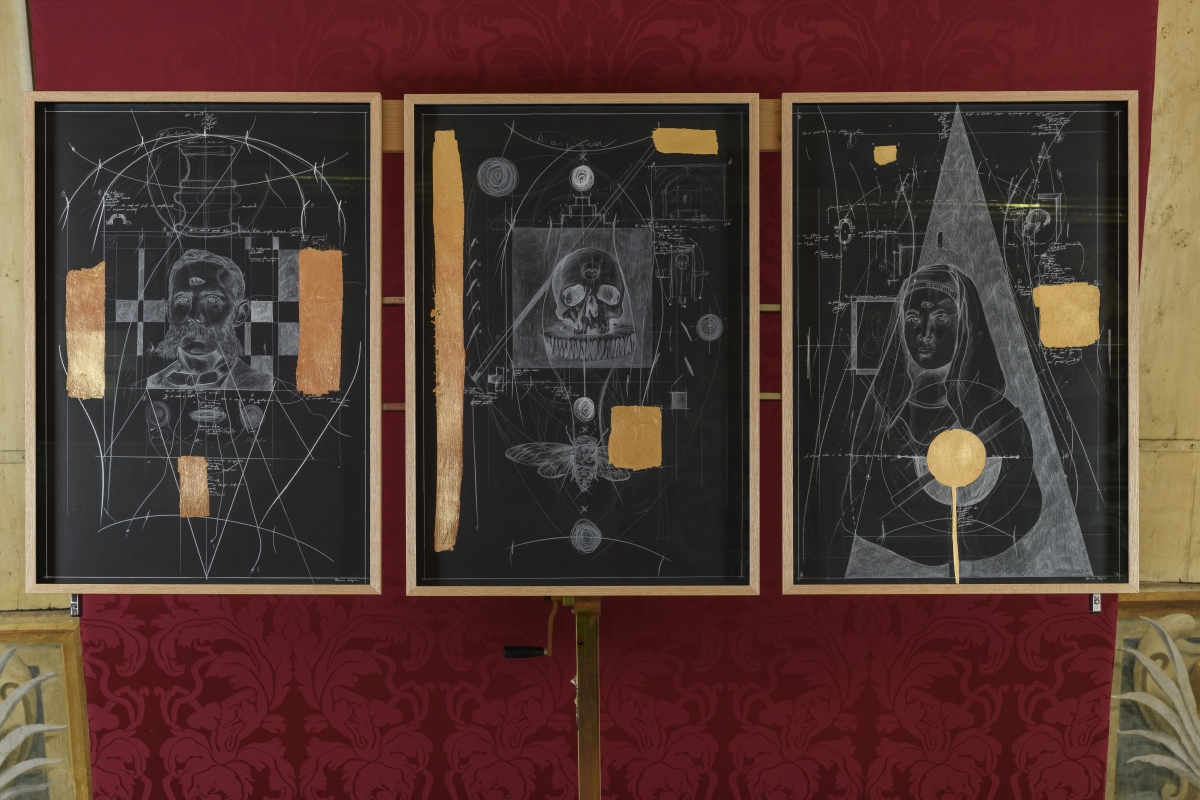
A stereoscope. Maybe this is the most appropriate image to realize Fabrizio Cotognini artistic universe which displays the experience of time in progressively optical terms. Time becomes human if it is expressed according to a figurative criterion, and the illustrated expression develops its complete meaning when it becomes condition of temporal existence. Therefore, as in the stereoscopic view so in this approach, two images and a double perspective of the object are needed to see something laying out in the time. Do not mistakenly believe that a multifaceted sight will not lead to any truth; on the contrary, the variety of levels assures importance and guarantees the truth a meaning in the simultaneity of its images – none of which demands for more soundness because every image is part of the others. The artistic ability takes on importance thanks to what it hides, its binocularity consists in being able to keep one eye open on the visible while the other perceives the invisible halo.
The works of Cotognini are the stage where time, intended as fourth dimension holding the other three, is meant to become visible: the pieces show the bond between space and time, allowing the recognition of one in the other. Words, nuances, structures, figures and maps, which can appear to prophane eyes just as fragments, handwritings, precarious and unstable geometries, come to life and speak, telling where they came from, and strongly exhibit the suggestion they are able to make the observer feel. It happens as in a wonderful scenic presentation where an extraordinary effect, previously hidden backstage by the director, is gradually spread: without any obvious logic, the works unexpectedly light up, get coloured, animate and got covered by moving signs which trigger a phenomenal imagination, and shape and combine images and architectures, creating a prodigious phantasmagoria. The visual impulses shake the imagination, the surprise grows and, at the end, all the fantastic elements unite in a kaleidoscope of colours, shapes, charms and stories appearing after having been invisible in the oblivion domain for a long time. The attention is never caught by single isolate images, rather there is an intermittent simultaneity of them that answers to a unique name and becomes identity. There is more than a revival of time: every living thing and place is subjected to the centripetal force of time which allows only fragments to be seen. The re-identification of them tastes as a discovery, even a creation, because in Cotognini kaleidoscope it is possible to find both an order and the intuition of a unitary image.
Trying to compose a unit from a fraction let one realise that, when the reality understood with direct observation meets the reality built on the line of time, a third reality takes shape; a reality able to produce re-identification of a third thing, a new image, which is distinguished by its distance from the other two as the only figure in relief. In this way the re-identification is not mere reproduction, but a process of conception ex novo: the emerging procession of images, the pouring of imagination from the furthest parts, the infinite number of stories re-identify themselves, by all mean possible, as belonging to both the past and the present; therefore, they are extratemporal because from them emerges the view of the universe set in the deforming prospective of time. The eye allowing this re-identification is set on time, simultaneously rather than in succession.
So, it is not humanity holding the time but vice-versa, that’s why to re-identify, being free from similarities, reveals in advance the last sense of time and makes it true, suggesting how much has not been perceived and unveiling its discontinuous structure. Cotognini infuses a sense of beauty and strength, he appears as a giver of life and energy, a hatcher of plots among fragmentary images that indirectly donate themselves, denying their being and having nothing to do with the meaning of their names. It is as if being things and dissembling their own shape could bring to a more persistent reidentification than the one obtained by ordinary optical confirmation. He is brave in choosing not to reduce the real to an alleged totality, and he searches – and finds- his own sense in the meeting with the world, which is possible only if nothing is consecrated definitively. Thus, the marked verticality which connotates his figures, architectures and handwritings specifically refers to that temporal simultaneity in which the combining element of the optical and stylistic solutions can be found. Therefore, simultaneity has to be intended as the common denominator between the figured expression and the stereoscopic view of the reidentification: in both cases it is about to see and think two -apparently- distant things under only one denomination at the same time. Cotognini offers to us, kosmos-theoretical being by nature, in need of totality and animated by the hope for a panoramic vision of the infinite that we temporary inhabit, the possibility of grasping unitary images thanks to their distance from the model, instead of their similarity. Besides, we only own shapeless and incomplete visions, completed by arbitrary ideas that create dangerous suggestions. And if it is true that every observer, when observes, observes him or herself because the piece is just an optical tool, so these pieces are singular images of something known, different from the ones we are used to see. Singular and yet authentic, and twice as compelling because they amaze, break the control of habit and, recalling an impression, they permit us to regain consciousness. And we wonder when, rather than the imagined world, we face the visible world which he, Fabrizio Cotognini, creates and contaminates with his magical lantern, softening the borders of imagination and perception, depriving all the shapes of their own punctual character and doubling them, continuously, with a phantasmagorical halo.
Elsa Barbieri